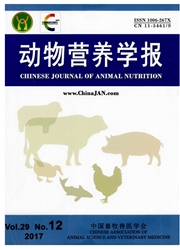

 中文摘要:
中文摘要:
本文旨在研究猪的体重和品种对其背最长肌的肌肉生长抑制素基因表达的影响,并对猪100kg时的胴体性状与肌肉肌肉生长抑制素基因表达量的相关性进行分析。试验采用荧光定量PCR方法,以β-actin基因为内标,研究不同体重(20、50和100kg)和品种(汉普夏猪和长白×撒坝猪)对猪背最长肌的肌肉生长抑制素基因表达的影响,同时考察试验猪在100kg时的胴体肉质指标。结果表明:①猪背最长肌中肌肉生长抑制素的表达随体重的增加呈上升的趋势(P〉0.05);②相同体重条件下长撒猪背最长肌中肌肉生长抑制素表达均显著高于汉普夏猪(P〈0.05),其中20kg时达到极显著水平(P〈0.01);③肌肉生长抑制素的表达与瘦肉率呈极显著的负相关(P〈0.01),与背膘厚则呈极显著的正相关(P〈0.01),与滴水损失和肌内脂肪的相关性不显著(P〉0.05)。本研究结果表明猪背最长肌的肌肉生长抑制素基因的表达量随体重增加而提高,品种间差异显著,并且肌肉生长抑制素基因的表达与瘦肉率、背膘厚存在显著的相关性。
 英文摘要:
英文摘要:
The effects of body weight (20, 50 and 100 kg) and breed (Hampshire and Changsa) on expression of porcine longissimus myostatin gene and its correlation with the carcass quality of pigs with a body weight of 100 kg were investigated. The real-time fluorescent quantitative RT-PCR with β-actin mRNA as internal standard was applied to determine the level of myostatin mRNA. The results showed that 1) the expression of longissimus myostatin had an increasing tendency in both breeds of pigs with the increasing of body weight (P〉0.05) ; 2) the expression of longissimus myostatin gene of Changsa pig was significantly higher than that of the Hampshire pig with the same body weight (P〈0.05), and extremely significantly higher when the body weight was 20 kg (P〈0.01) ; 3) the expression of myostatin had greatly significant positive correlation with backfat thickness (P〈0.01)and greatly significant negative correlation with lean percentage (P〈0.01), but no significant correlation with the drip loss and intramuscular fat (P〉0.05). The results demonstrated that the expression of longissimus myostatin gene increased with the growth of body weight and was significantly affected by breeds of pigs. The results of the correlativity analysis among myostatin, carcass quality and meat quality indicated that the expression of myostatin had different size correlation coefficients with carcass quality and meat quality.
 同期刊论文项目
同期刊论文项目
 同项目期刊论文
同项目期刊论文
 期刊信息
期刊信息
